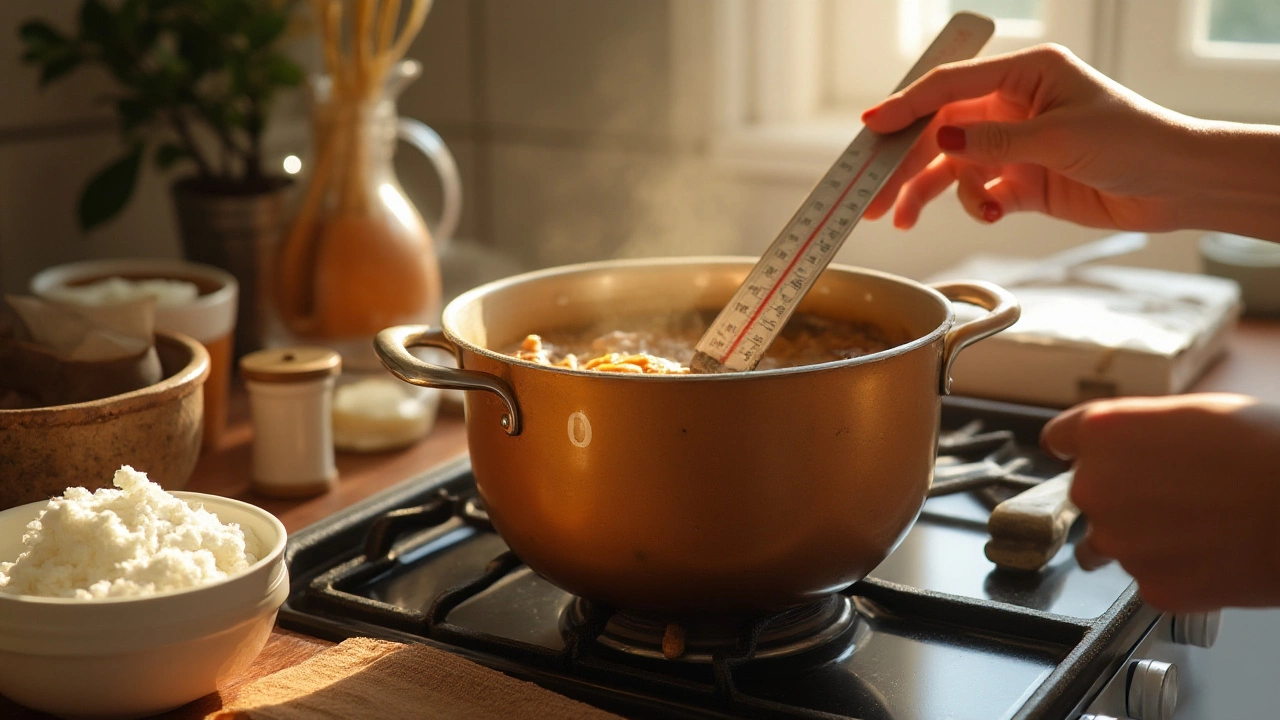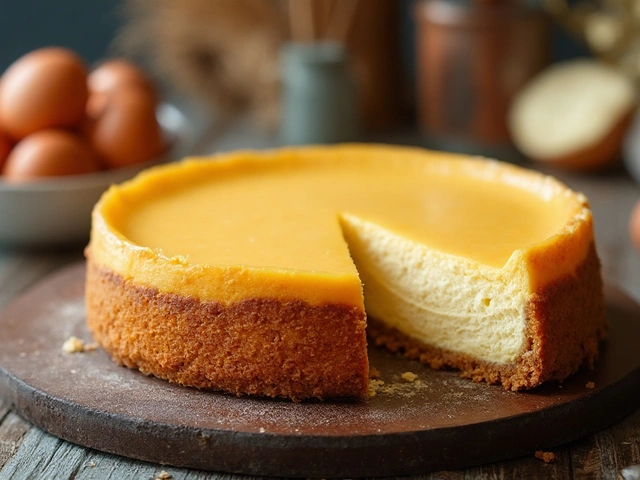
There are those moments when we try whipping up a batch of fudge, and instead of smooth, creamy goodness, we end up with something resembling toffee. But rest assured, with a little bit of magic (and patience), it can be transformed. Though condensed milk often comes to mind when thinking of fudge fixes, we'll explore alternatives that don’t require it.
Understanding the science behind your confection's transformation is key. Sugar's behavior changes remarkably due to temperature and technique, which can make all the difference between fudge and toffee. Let's dive into why your fudge might have gone astray and what you can do to bring it back to perfection.
- The Science Behind Fudge and Toffee
- Identifying the Problem
- Temperature Adjustments
- Tweaking Ingredients
- Patience in Fudge Making
- Tips for Future Attempts
The Science Behind Fudge and Toffee
Fudge and toffee might appear as mere confections to devour when cravings hit, yet they are illustrations of sugar's fascinating behaviors. At first glance, both these sweet treats share sugar, butter, and cream as primary ingredients, stirring a delightful confusion regarding how they differ. The key distinction arises from their individual unique processes, particularly how sugar is cooked, which impacts texture, flavor, and even the glossiness of the final product.
Sugar starts off as a simple, crystalline compound. When making fudge, the process aims to keep sugar from crystallizing early, for that would result in a gritty texture. Fudge requires what’s known as a supersaturated solution. Here, sugar is meticulously dissolved in water and heated to a precise temperature, usually in the 'soft ball' range (around 238°F to 240°F). This temperature allows the sugar to dissolve into smoothness, which, after cooling and stirring, transforms into creamy fudge. Meanwhile, toffee's process leans towards caramelization—sugars are cooked to higher ranges, often exceeding 300°F. Such high temperatures give toffee its distinctive brittle texture and deep, amber color.
Fudge recipe success relies heavily on understanding and manipulating these temperatures. In fact, confectioners might even check the humidity levels before starting, as moisture in the air influences how sugar behaves. Too much moisture, and the sugar might fail to set correctly, edging dangerously towards toffee territory. Cooking sugar is truly an art and a science, where even the smallest deviation can result in a different treat than you anticipated. As food historian Alan Davidson once noted, "The allure of sugar lies in its willingness to morph with a mere flicker of heat."
Drafting a perfect batch of fudge without reaching toffee-esque results can also be influenced by the rate of cooling. Fudge benefits from a slow, controlled cooling phase. This allows sugar crystals to form consistently, preventing the coarse texture peculiar to toffee and ensuring each bite is melt-in-the-mouth smooth. Sometimes, confectioners might employ a technique called 'stirring at the right time’ during cooling, further aiding in achieving a desirable fudge finish. Consider this the difference akin to the patience needed in making a soufflé rise just right. The art of fudge-making can be just as exacting.
Within the realm of confections, success can come down to a deep understanding of these scientific principles—transforming mere ingredients into something more. Precision, patience, and a bit of sugar wizardry are needed to manage a delectable result, as we dance on the narrow line between fudge fix failures and toffee triumphs. Given this knowledge, you're now equipped to tackle your next batch with certainty and fix any that strive a little too close to brittle territory.
Identifying the Problem
When your fudge turns unexpectedly hard, resembling more of a toffee texture, it's important to determine where things might have gone off track. This often involves a few critical areas: sugar saturation, temperature control, and timing. Each plays a pivotal role in the chemistry of candy making, and mastering these elements will help you turn your dessert back into the creamy fudge you originally envisioned. Sugar saturation, for instance, is the first place to start. If the sugar didn't properly dissolve during the initial stages, you're setting the foundation for less than perfect results. Stirring over low heat until the sugar grains completely vanish is a crucial step. Without this, you're more likely to face issues as the recipe progresses.
Temperature is another common culprit. Cooking your mixture too long or at a too-high temperature effectively turns your sugar syrup into a hard candy stage instead of a soft fudge consistency. Utilizing a candy thermometer isn't just a suggestion but a necessity for achieving precise results. Ideally, your mixture needs to settle at a perfect 234°F to 237°F—or the so-called softball stage. Without reaching—or exceeding—this specific temperature, it’s probable that your fudge ends up with the wrong consistency. Timing this step perfectly allows your fudge to set up properly, ensuring it remains soft but firm enough.
Timing issues also extend to the period after cooking. How you handle the mix as it cools can influence the final result. If beaten too soon or too late, the structural integrity of the fudge compromises, leading to a granulated or rock-hard texture. This sweet spot usually occurs when the mixture cools down but isn’t set yet, allowing it to reach the right texture. As culinary expert Harold McGee wisely notes, "Understanding the natural stages of sugar heat can be the difference between successful candy and crystallized disappointment."
"Understanding the natural stages of sugar heat can be the difference between successful candy and crystallized disappointment." – Harold McGee
While these factors are generally the usual suspects in the case of fudge gone awry, don’t forget that external environmental conditions can also interfere. Humidity can sometimes add an extra layer of complication by introducing unwanted moisture into the mix or affecting cooling times. Each of these aspects, individually or in concert, can contribute to why your fudge might look a lot like toffee. Recognizing these potential pitfalls ahead of time arms you with the knowledge to troubleshoot and refine your techniques next time around.

Temperature Adjustments
For those moments when you find yourself face-to-face with a batch of fudge that has sadly transformed into chewy toffee, temperature is typically the culprit. Fudge fix begins with understanding that sugar is incredibly sensitive to heat. In candy-making, precision is everything. When making fudge, it's critical to reach the exact stage where the sugar crystals are small and the mixture is smooth. If the temperature goes too high, the result is a harder, toffee-like texture.
The ideal temperature for fudge is around 235°F to 240°F, often referred to as the “soft-ball stage.” Investing in a reliable candy thermometer can be a game-changer. Many kitchen thermometers may lose accuracy over time, so ensure yours is properly calibrated. A simple test involves placing it in boiling water; it should read approximately 212°F, the boiling point of water at sea level. If your fudge recipe exceeds the necessary temperature, sugar sets more firmly and creates results akin to toffee.
Temperature adjustments also mean reacting swiftly if you see signs of overheating. If your mixture begins boiling too vigorously, promptly lower the heat. A gentle, rolling boil ensures that the temperature rises steadily rather than racing past that critical soft-ball stage. This may be a case of trial and error, but with practice, you'll develop a sense of timing and temperature control. A blockquote brings in a touch of wisdom, "Candy making is as much science as it is art, and understanding the behavior of your ingredients is the key," as noted by a noted confectionary expert.
In the absence of a thermometer, there's an old-fashioned method called the cold water test. Dropping a bit of your hot mixture into cold water will inform you of its progress. Fudge should form a soft ball that flattens when pressed between your fingers. By steering clear of the hard crack stage where you make toffee or brittle, you keep your sweet delight in the realm of soft and creamy. This small, somewhat tactile test can be a lifesaver when technology isn’t on hand immediately.
Patience plays a significant role in candy making. If there’s one rule in fudge making, aside from temperature, it's to never rush. The temptation to crank up the heat to speed things along often leads to disaster. For most sweets, particularly toffee fudge, patience pays off with the ultimate reward of heavenly smoothness. By concentrating on temperature control, you not only rescue this batch but gain skills for crafting even better batches in the future.
Tweaking Ingredients
When your fudge turns more like toffee, frustration can set in, but it's essential to remember that every misstep is a new learning curve in the art of baking. The texture resultant of your sugar concoction owes much to the ratio and chemical interplay of its ingredients. Common culprits like butter, cream, and milk are not only necessary for flavor but integral in reaching the desired consistency. Making adjustments to these ingredients can sometimes save your batch from the brink. Start by assessing the usage of butter. Adding a tablespoon or two can often work wonders. Butter not only brings a creamy texture but also aids in lowering the temperature at which sugar crystallization begins. This delicate dance of ingredients is the heart of a successful save.
Consider the role of heavy cream or whole milk in the original recipe. If your fudge veers into toffee territory, it often means rebalance is needed. Cream and milk temper the sugar's reaction to heat, offering a canvas for smoothness. In such cases, gently rewarming the mixture and gradually incorporating a small amount of warmed cream or milk may coax the fudge into a smoother state. Remember to stir constantly to blend the additions thoroughly and avoid any unwanted separation.
Sometimes employing an unexpected ingredient can turn the tide. Marshmallows, for example, subtly alter the sugar structure, providing a light and fluffy texture when melted into your mixture. Their composition of sugar, water, and gelatin amplifies creaminess in an almost magical way. This can be particularly advantageous if you're absent condensed milk and stuck in a sticky situation. Introduce roughly one cup of miniature marshmallows, stirring continuously till seamlessly incorporated, watching as they melt into the batch, creating a lush, renewed consistency.
On a lighter note, it's often said that kitchen improvisation is an art; Julia Child remarked,
"The only real stumbling block is fear of failure. In cooking, you've got to have a what-the-hell attitude."Embrace experimentation without fear, as each trial brings valuable insight into culinary science. Reworking your recipe may also coincide with adding a pinch of salt or a teaspoon of vanilla extract, as these trusty allies work behind-the-scenes magic on flavor and sugar properties.
Within the realm of sugar solutions, remember that it's all about balance and harmony among the elements. While scientific theory underscores the practical aspect of repairing fudge, adjustments are sometimes best guided by intuition and a taste test. Trust your culinary instincts. After all, rescuing your fudge is merely an excellent excuse to learn something delicious.

Patience in Fudge Making
The process of making ***fudge*** truly tests one's patience, which is as crucial as any ingredient in your recipe. Often in our excitement or haste to taste the sweet rewards, we may rush this delicate process, leading to unexpected results like toffee instead of creamy fudge. Time is an essential ally when cooking confections; letting sugar heat gradually allows for better dissolution and prevents premature crystallization, a common issue when making fudge.
Imagine sugar as tiny grains longing for transformation; they need their time to align perfectly with butter and cream. When these elements come together at a steady pace, they interlock into a smooth matrix; when rushed, they become rebellious, forming crystalline structures reminiscent of toffee. It is during this phase that even a slight mishap in temperature can drastically alter the texture, so attending to the mixture with patience ensures that these grains melt and merge seamlessly.
You might recall the saying by the famous chef Julia Child, 'The only real stumbling block is fear of failure. In cooking, you've got to have a what-the-hell attitude.'
The more you invest yourself into the art of making fudge, the more you'll notice that patience not only brings success but also a calm satisfaction as you stir and observe the bubbling mixture. The anticipation enriches the experience, making the end result much sweeter.
Another critical aspect is allowing the fudge mixture to cool patiently. Rushing to the cooling stage or attempting to manipulate it too early can cause gritty, crumbly textures. As **fudge** sets, the slower cooling aligns the sugar crystals uniformly, ensuring that coveted smoothness. This patience, which might feel dull or testing, eventually pays off when you cut into a piece that's lush and melts in the mouth.
An interesting tidbit is the temperature chart used by confectioners. During the critical boil, reaching between 234°F and 236°F is what some historians of confection call 'soft-ball stage'. Anything less, and your sugar doesn't set properly; more, and you edge closer to toffee territory. Perhaps it sounds complicated, but having a reliable candy thermometer and a bit of perseverance will soon make these metrics second nature.
Patience is not just a virtue here—it is the foundation for perfect fudge making. Remember that fudge is as much about technique as it is about heart. The rhythm of stirring, the watchful gaze over the simmering pot, and the gracious act of waiting all come together to create not just a dessert, but a piece of culinary art, echoing a tradition that has delighted generations.
Tips for Future Attempts
Crafting the perfect fudge is a dance of technique, patience, and a little bit of science. To make sure that your next batch doesn't morph into an unintended toffee, there are several tips to keep in mind. One crucial factor is the control of temperature. Always use a reliable candy thermometer, as the right heat is vital to achieving that smooth, creamy texture that defines fudge. A great saying by confectioners is, "When in doubt, check the temperature again." Overheating causes the sugars to over-caramelize, giving you that toffee-like hardness. Aim for firm ball stage, usually around 235°F (113°C), for results that hit that sweet fudge spot.
Next comes the stirring process, which is as critical as the heat itself. Once you've removed the mixture from the stove, let it cool down without any agitation. Stirring too soon won't allow the sugar to set properly, increasing the risk of crystallization and making your fudge grainy or overly chewy. Once cooled to about 110°F (43°C), begin to stir in a rhythmic and gentle manner until the glossy sheen dulls. This is where patience pays off; watch as it transforms to perfection under your steady hand.
Another helpful approach is practicing ingredient accuracy and measuring your dry and wet components correctly. Even a slight variation in butter or cream can lead to a textural deviation. Consider using the same brand of ingredients each time, as minor differences can stack up and alter the outcome. If you're substituting ingredients—such as using milk instead of cream—be mindful of moisture compensation and fat content since these influence both flavor and texture.
Confectionery is, after all, a precise art. Take detailed notes with every batch, listing what worked and what didn't. This documentation can be invaluable, especially when trying different flavors or textures. You might also want to experiment with different recipes that allow for variations. Traditional recipes often have room for creativity, so once you're comfortable, try tweaking flavors or adding nuts and fruits for a personal twist.
"Perfection is attained by slow degrees; she requires the hand of time," said Voltaire. This rings profoundly true in fudge making. The more you practice, the more intuitive the process will become. You'll eventually find your own rhythm, recognizing when the mixture hits the right notes and when it calls for adjustments.
Finally, don't hesitate to share and compare your experiments with fellow bakers. Joining a local baking group or online forums might offer new insights and learning experiences that can only make you a better confectioner. Troubleshooting together can unveil shared challenges and solutions. Remember, every batch is an opportunity to learn, and maybe next time your fudge will melt in your mouth just as you imagined.





